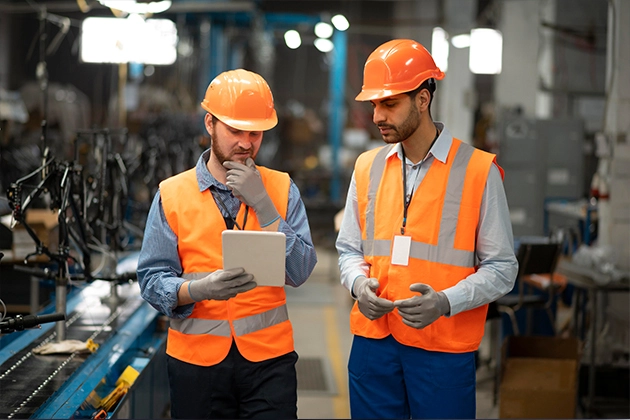One critical factor that frequently goes undetected in the hustle and bustle of industrial workstations is the quality of the air we breathe. The persistent pursuit of productivity might accidentally turn the air around us into a breeding ground for dangerous chemicals and toxins.
Comprehensive breathing air quality testing is critical for safeguarding the health and safety of employees in these workplaces. However, education and awareness are the ultimate change agents.
When it comes to implementing effective breathing air quality testing practices in industrial workplaces, the importance of education and awareness cannot be stressed. It enables employees, managers, and decision-makers to take proactive efforts towards building healthier and safer working environments by providing them with information and awareness of the possible hazards connected with poor air quality.
However, education alone is insufficient. Awareness acts as a link between knowledge and action. We create a collective consciousness that pushes organisations to prioritise the well-being of their workers by increasing awareness about the necessity of breathing air quality tests.
Individuals become active participants in advocating for and executing frequent air quality evaluations when they are aware of the possible hazards and accessible remedies.
Understanding the Hazards of Poor Air Quality
Air quality in industrial environments is a major issue. Poor air quality might aggravate pre-existing respiratory disorders. This causes more absenteeism and poorer productivity, which reduces the company’s profit.
Long-term exposure to hazardous particles can result in catastrophic diseases including lung cancer. For example, welding or metal cutting can cause fume fever, which causes weariness and flu-like symptoms. Another risk is the production of toxic gases during manufacturing. These gases are potentially combustible, corrosive, or irritating.
Ways to Promote Good Breathing Air Quality in Industrial Workplaces
Proper Ventilation Systems
To maintain worker safety, effective air quality control in industrial environments necessitates a variety of measures. Exhaust fans, air conditioners, and dust extractors are installed to provide good breathing air quality.
A healthy working environment requires proper ventilation. They take polluted air and replace it with fresh outside air, lowering humidity and avoiding mould and fungal growth.
Airflow rate, frequent maintenance inspections, and usage instructions are all factors to consider in HVAC design. By maintaining appropriate ventilation and effectively eliminating dangerous pollutants, these steps help to maintain a healthy working environment.
Engineering controls, such as continuous monitoring of air quality data via sensors, can also be installed with ventilation systems. This aids in detecting temperature or particle concentration changes that indicate insufficient ventilation.
To guarantee excellent breathing air quality in industrial settings, employers must comply with air quality requirements, teach personnel about use methods, and encourage environmental awareness.
Effective Use of Personal Protective Equipment
To preserve air quality in industrial environments, it is critical to deploy efficient Personal Protective Equipment (PPE). PPE protects employees against inhaling toxins that can cause short- and long-term health concerns such as respiratory difficulties, asthma, and even lung cancer.
Respirators and masks are examples of common PPE. While masks just protect the nose and mouth, respirators filter pollutants before inhalation. For various working settings, proper PPE is required.
Ensure that all personnel understand how to correctly wear and replace breathing equipment. Proper maintenance is vital since improper upkeep might diminish the efficiency of the equipment.
Regular Maintenance and Cleaning of Equipment
Industrial workplaces need regular maintenance and cleaning of their equipment for fresh air. This prevents harmful particles from floating in the air and causing respiratory issues. Stick to these steps to achieve ideal conditions:
- Set up a schedule for cleaning all equipment.
- Thoroughly clean each tool after use.
- Check equipment regularly for any signs of damage.
- Always keep a stock of spare parts for repairs.
- Train employees on the right way to use and clean equipment.
These steps will not only promote good air quality but also boost productivity. Different types of equipment have various maintenance needs based on complexity and frequency of use.
By maintaining and cleaning equipment regularly, you can help your industrial workplace breathe easy. This raises employee morale, reduces respiratory illness risk and improves productivity.
Summary
Education is a critical component in ensuring excellent air quality in industrial sites. Workers may be exposed to harmful airborne pollutants that cause respiratory ailments and other illnesses if they are not aware of the impact of poor air quality on health.
Employees can be protected from exposure to these toxins by regularly maintaining ventilation systems and wearing appropriate PPE. However, employees must be educated on how to maintain acceptable air quality.
Discussions on possible risks and precautions can teach workers how to protect themselves. Posters, movies, booklets, and interactive training sessions can help staff understand what they need to perform.
Workers who have been trained in excellent breathing air quality can detect when the air is contaminated or safety protocols are violated. They should also feel comfortable speaking up if they suspect there is a problem since this fosters a safer workplace.










